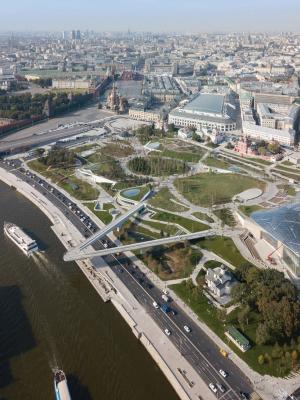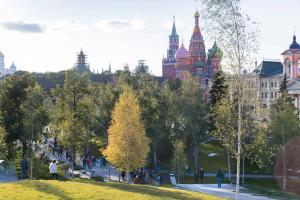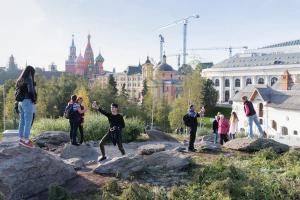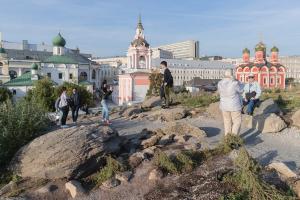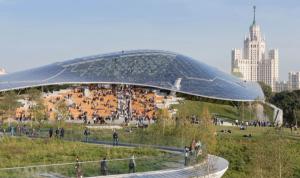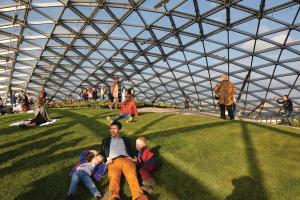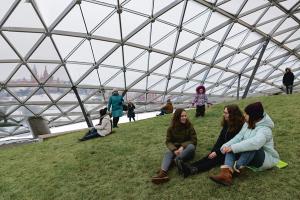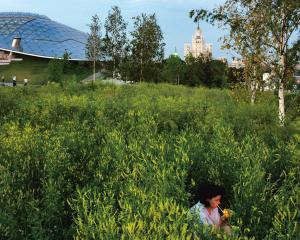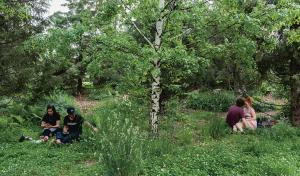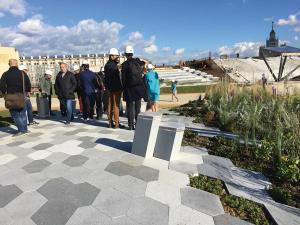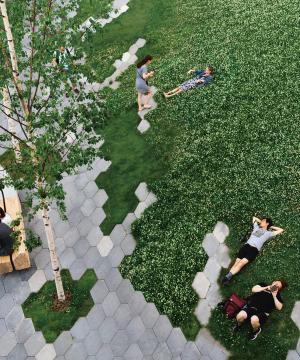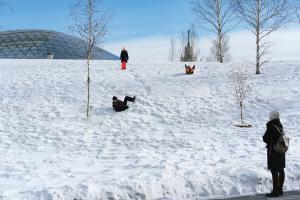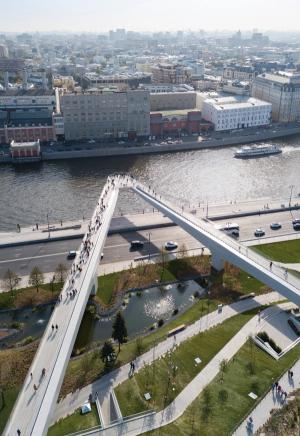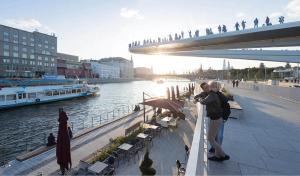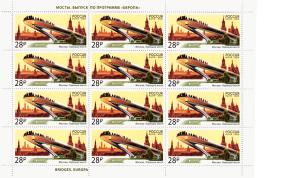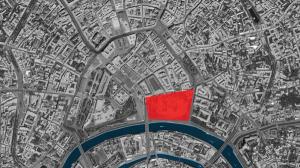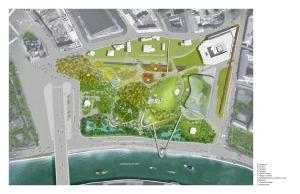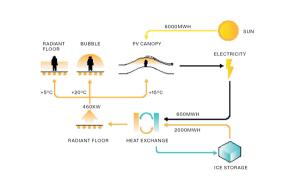ZARYADYEPARK
MOSCOW,RUSSIA
Zaryadye Park, Moscow’s first new park in half a century, sits on a culturally charged site surrounded by the Kremlin, Saint Basil’s Cathedral, Red Square, a row of Eastern Orthodox churches, and the Moskva River. The Zaryadye district has a rich history. It was abandoned by affluent nobles when Peter the Great moved the capital to Saint Petersburg, in 1712. Following the Fire of Moscow, in 1812, it hosted the city’s largest Jewish enclave. While many Russian Jews emigrated after the pogroms of the 1880s, Zaryadye remained a Jewish neighborhood. After the 1917 October Revolution, Joseph Stalin planned to build a skyscraper on the site to house the People’s Commissariat of Heavy Industry in the style of the Seven Sisters, a skyscraper complex erected across the city, but the scheme was never realized. Ultimately, Premier Nikita Khrushchev built the three-thousand-room Rossiya Hotel on the site in the mid-1960s. The hotel was razed in 2006 to make room for a mixed-use development, but the city decided to build a public park instead.
The selection of an American team to design a Russian civic landmark was unlikely given the political implications at the time. U.S.-Russian relations were already strained over Vladimir Putin’s decision to give asylum to Edward Snowden, the American computer-intelligence consultant and whistleblower who was charged with espionage after leaking highly classified documents concerning U.S. government surveillance programs. Hyperaware of this politically charged context, but intent on helping the mayor and the city’s chief architect evolve Moscow into a cosmopolitan city open to the world, the design team conceived the thirty-fiveacre park as a democratic place for Muscovites and visitors to enjoy. Offering a variety of spaces—from hidden nooks to wide-open fields and meadows—for expressing oneself individually and collectively, the design was in defiance of the brief, which specifically prohibited places where large crowds could assemble.
Zaryadye Park blurs the edges between hardscape and landscape, seamlessly knitting together man-made and natural elements. Visitors traverse environments that re-create and celebrate the biodiversity of four regional landscapes found in Russia: tundra, steppe, forest, and wetland. This variety stands in marked contrast to typical Russian parks, which prescribe a small inventory of approved species to be planted in manicured gardens. These four zones are organized in terraces that descend from northeast to southwest, each layering over the next like giant shingles. Amenities totaling fourteen thousand square meters of temperature-controlled interior space are tucked under the cascading landscape to allow the total footprint of the park to exist as uninterrupted green space. The programmed amenities include a media center, a nature center, a restaurant, a market, and two amphitheaters.
The new park includes augmented microclimates that extend Moscow’s typically short park season through the severe winter months. Passive climate-control strategies include calibrating the topography of one of the park’s landscaped hills, which doubles as the roof of a new concert hall. Leveraging the natural buoyancy of warm air, an open-air glass crust floating over the hill produces a comfortable thermal climate throughout much of the year, allowing grass and other plants to thrive in winter while providing a pleasant perch for enjoying views over the city. This uncanny evergreen hillock remains mild and verdant even in blizzard conditions. While the air temperature is thirty-two degrees Fahrenheit, it can be a comfortable sixty-four degrees under the crust. Motorized glass panels open to allow heat to escape through the roof in the summer. Although the park is separated from the Moskva by a multilane highway, visitors can enjoy the view from a boomerang-shaped pathway, which cantilevers two hundred feet toward the river.
Regimes may come and go, but successful civic assets tend to stay put. Aside from its new name, the People’s Park, Zaryadye Park resists attempts to politicize it and presents a hopeful vision for Russia: uninhibited, upbeat, and at peace. Zaryadye Park was designed in collaboration with Hargreaves Jones and Citymakers.
| Client | City of MoscowSergey Kuznetsov, Chief Architect of Moscow | Size (GSF) | 1510001 |
| Location Moscow, Russia | |||
| competition2013 | opening2017 |
| Partners | Charles Renfro,Elizabeth Diller,Benjamin Gilmartin,and Ricardo Scofidio |
| Project Leaders | David Chacon and Brian Tabolt |
| Designers | Ayat Fadaifard,Seongbeom Mo,Dino Kiratzidis,James Murray,Gabriel Bollag,Jack Solomon,Zoë Small,Trevor Lamphier,Michael Robitz,Lindsay Harkema,Jose Tijerina,Kelsey Olafson,Andreas Kostopoulos,and Bryce Suite |
| Sustainability + Ecology Director | Sean Gallagher |
| Hargreaves Jones | Master Planning and Landscape Architecture |
| Citymakers | Local Partner and Planner |
| Buro Happold | Engineering |
| Transsolar | Sustainability |
| Arteza | Native Planting Expert |
| Mobility in Chain | Transportation |
| Directional Logic | Cost Consulting |
| MAHPI | Architect and Engineer |
| Mosinzhproekt | Contractor |
